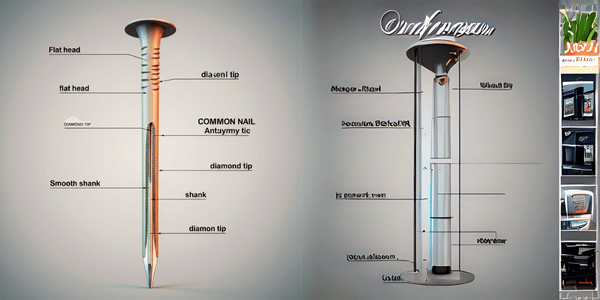Common Nails Demystified: Uses, Benefits & Types Explained
Updated: 15/05/2025
114
When did you ever give nails a thought? Not the flashy ones on your fingers, but the plain, everyday nails that hold the world together. If you’re working on a do-it-yourself home building project or creating some woodwork, then you’ve likely already handled a standard nail. Though they seem plain, these small but mighty tools are the behind-the-scenes heroes of building and craft projects.
This guide will break down everything you need to know about common nails. From their versatile uses and key benefits to their various types and how to choose the right ones for your project, we’ve got it all covered. Read on to unravel the mystery behind these essential building blocks!

Key Takeaways:
- Versatile Usage: General-purpose nails are required for a variety of applications, including framing, cabinetry, flooring, furniture repair, and heavy construction.
- Budget-Friendly: They are cost-effective for small DIY projects and massive construction projects.
- Reliable Durability: This product is designed to be incredibly sturdy, ensuring that it holds everything securely and keeps joints from becoming loose as time goes on.
- Finish Matters: Galvanised finishes are appropriate for exterior use, while bright and black oxide finishes are appropriate for interior use.
- Size and Fit: When working on your project, it’s crucial to choose the right nail size and type that suits the materials and environment you’re dealing with. This will ensure you get the best results!
What is a Common Nail?
A common nail is a versatile type of hardware with a straightforward yet effective design. It features:

- Flat Head: Perfect for hammering into wood with ease.
- Smooth Shank: Designed for strength and durability.
- Sharp Diamond Tip: To drive through materials effortlessly.
General nails are unlike speciality nails, such as finish or roofing nails, because they are designed for heavy use. Their thickness and large size are ideal for holding wood and framing. Having trouble identifying one? Picture a strong, long nail with a large head designed to withstand hard hammering!
Anatomy of a Common Nail
(Infographic Placeholder)

Alt Text: Diagram showing the flat head, smooth shank, and diamond tip of a common nail.
The Versatile Uses of Common Nails
Common nails are true multitaskers. Here’s where they shine the brightest:
- Framing Walls: Common nails are go-to elements for connecting wooden studs in walls. Their length and strength make them indispensable in framing tasks.
- Flooring Projects: Used in “face-nailing,” common nails help secure floorboards, ensuring they stay in place for years.
- Furniture Repair & Assembly: Dyers and carpenters rely on these nails to repair and assemble wooden furniture quickly.
- Cabinetry & Woodworking: Whether you’re building cabinets or a custom bookshelf, common nails lift the heavy weight (literally)!
- General Construction: From wooden beams to roof trusses, contractors use common nails in almost every construction project.
Curious about where else they fit in? Common nails are loved equally by contractors, builders, and DIY hobbyists because of their adaptability. If you’ve nailed a home décor project recently, chances are, you’ve already put it to work.

Example: “When constructing a wooden garden bed, I used 16d galvanised nails from [Brand/Website] to create a sturdy, weather-resistant structure.”
Key Benefits of Using Common Nails
Why should you choose common nails over other options? Here are some standout benefits:

- Affordability: Common nails are budget-friendly, making them accessible for small-scale DIY projects and large-scale construction alike.
- Durability: These nails are built to last. Their sturdy construction gives them excellent holding power, preventing joints from loosening over time.
- Corrosion-Resistant Options: Galvanised common nails are perfect for outdoor projects, as they resist rust and damage from moisture.
- Ease of Use: Their design ensures that even novice Dyers can hammer them comfortably without splitting wood. Want to save time and effort on your next project? Common nails might just be your perfect sidekick.
Types of Common Nails You Should Know
Based on Size (Penny System)
You’ve probably seen nails labelled as “10d” or “16d.” This penny system indicates the length of a nail. For instance:
- 10d Nails (3 inches): Best for smaller framing projects.
- 16d Nails (3.5 inches): Great for heavier construction projects like structural framing.
Not sure what size to use? For framing, go with 16d; for panelling, try shorter 10d or even 8d nails.
Based on Finish
Knowing the finish can make all the difference for durability and aesthetic value:
- Bright Finish: Ideal for indoor applications where moisture isn’t a factor.
- Galvanised Finish: Perfect for outdoor use, as the zinc coating offers excellent rust resistance.
- Black Oxide Finish: Adds a touch of elegance to indoor projects, blending seamlessly with darker wood tones.
Pro Tip: Choose a finish that complements both your project’s material and its environment.
Choosing the Right Common Nail for Your Project
When selecting the perfect nails, consider these factors:
- Project Type: For framing, large nails (like 16d) are your best bet. Decorative woodworking? Opt for black oxide finishes.
- Material Compatibility: Working with hardwood? Use galvanised nails for extra holding power. Softwood? Regular bright nails will do the job.
- Environmental Conditions: For outdoor projects, corrosion-resistant options like galvanised nails are essential.
Quick Tip: Create a checklist outlining your project type, material, and environment before heading to the hardware store.
Tips for Properly Using Common Nails
Even the simplest tools need some technique. Here’s how to use common nails like a pro:
- Hammer with Precision: Hold the nail in place with pliers or your non-dominant hand. Hammer lightly at first, then drive it in with firmer strikes.
- Use Tools Like Nail Sets: For wood surfaces, a nail set can help sink the nail head below the surface for a cleaner finish.
- Ensure Safety First: Always wear gloves and safety goggles to protect your hands and eyes from flying debris.
Fun Facts about Common Nails
- Ancient Origins: Nails date back to Ancient Egypt, where they were forged from bronze.
- Modern Evolution: Cut nails evolved during the Industrial Revolution, leading us to the common nails we use today.
- Staggering Stats: An average home uses roughly 20,000 nails from start to finish!
- How’s that for perspective?
Conclusion: Unlock the Power of the Perfect Nail
Common nails might be the most underrated tools in your kit, but their practicality and versatility make them an invaluable asset for almost any project. From furniture repairs to full construction work, these everyday heroes hold it all together.
Next time you’re planning a project, take a moment to appreciate the humble common nail. Armed with the insights from this guide, you’re ready to choose the right nails for your needs and get the job done.
Looking for high-quality nails for your next project? https://theeverygirls.com/liquid-nails-on-concrete-for-reliable-bonding/ and take your DIY or construction projects to the next level!
FAQS about Common Nails
What are common nails typically used for?
Common nails are best suited for heavy-duty jobs like framing walls, building furniture, and general construction. They offer strength and reliability, making them a staple in any toolkit.
What is the penny system in nail sizes?
The penny system refers to the length of the nail, represented as “10d,” “16d,” etc. For instance, a 10d nail is 3 inches long, while a 16d nail measures 3.5 inches. Longer nails are typically used for larger projects like structural framing.
Can common nails be used outdoors?
Yes, but only if they’re galvanised or rust-resistant. A galvanised finish ensures they withstand moisture and won’t corrode in outdoor environments.
How do I avoid splitting wood with nails?
Use nails with sharp diamond tips and hammer them in at an angle to help reduce the risk of splitting. Alternatively, drilling a pilot hole can also prevent wood from cracking.
What’s the difference between bright finish and galvanized nails?
Bright nails are ideal for indoor, moisture-free projects as they lack rust protection. Galvanised nails, on the other hand, are coated with zinc to resist corrosion, making them perfect for outdoor applications.
How do I choose the right nail finish?
Consider where your project will be used. Indoor projects can use a bright finish or black oxide nails for aesthetics, while outdoor tasks require rust-resistant options like galvanized nails.
Please Write Your Comments